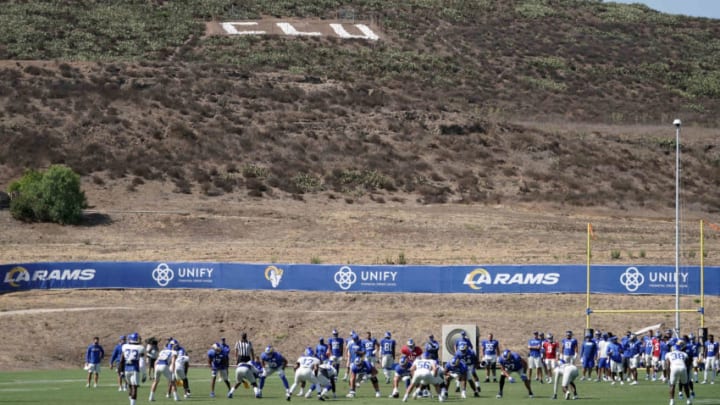If this were a normal year, the LA Rams‘ coaching staff team calendars would be set with dates for OTAs and minicamp by now. Planning could be already underway, a game plan in place that maps out how the team will go about installing new philosophies to a large contingent would already be set, and on the drawing board.
That contingent includes players from last year’s practice squad. You see, those players were actively signed up last year but didn’t see much playing time. (I guess that you could say that 2020 players who didn’t make the rotation were effectively red-shirted, although the NFL doesn’t use that term). This year’s free-agent signings face a huge logjam (to include the likes of veterans such as QB Matthew Stafford and WR Desean Jackson), along with the incoming new crop of drafted rookies and 17 undrafted free agents slated to be signed after the draft.
That’s a lot of new faces to orientate, to educate, to show the ropes.
Instead, uncertainty hangs in the air, as the NFL hasn’t yet informed teams of the framework, guidelines, or restrictions that might be in place for the current offseason. The league and the players association is supposed to meet this week, (remotely via Zoom, of course), to discuss this very matter.
We’re talking about practice
Coaches like certainty. Conjecturing and guesswork, not so much. Will the practice squad limit even still stay at 16 players again this year? Or will the sunrise of the COVID-19 allow teams to return to the 12 man practice squad? Or will the NFL and NFLPA agree to split the difference, and simply accelerate the 14 man practice squad scheduled for 2022? No one knows the answer yet.
It’s not as if the Rams are alone, however, as every NFL team is in the same quandary, wondering if it will be any different this year if the rules will be looser if things might open up a bit, return to some semblance of normalcy again for organized team activities, or OTAs.
Football work in the spring, which includes mandatory minicamps and the voluntary OTAs that begin with a gradual strength-and-conditioning phase, is based to a large degree on the need to develop young players.
Organized Team Activities (OTAs)
An OTA is kind of an umbrella term referring to practices and team meetings in the off-season, but it can encompass any number of team events, such as morale-building boot camps or even a bowling excursion to build team chemistry. OTA practices and meetings give players a small sampling, a taste, an inkling of what they’ll see in training camp and will have to learn for the regular season.
OTAs are the means to introduce new players on the team to the squad’s offensive and defensive schemes, as well as for new offensive or defensive coordinators to introduce new schemes to all the players.
In the past, a typical OTA day might start with a team meeting or a meeting between players and position coaches. That’s followed by some special teams practice and then individual drills with your position group. Later in the day, teams may work through seven-on-seven drills, no-huddle practices, and 11-on-11 practices.
But that was then, not necessarily now. Who knows what form it might take shape now.
Introductions are necessary
It’s an introduction, an opportunity to acquaint all the noobs to LA Rams culture 101. It’s not so very unlike spring college orientations for the incoming freshmen classes taking place at universities all over the country soon.
Last year, the NFL pulled off a tremendous coup by managing to pull off a complete season during a pandemic without as much as a single OTA session. This, of course, gives rise to the question of whether OTAs are still necessary at all.
Despite last year’s Covid-related workarounds such as Zoom-only meetings in the spring and no on-field workouts allowed until training camp – will this year be any different? As unlikely as it seems the NFL would recommend another all-virtual offseason, we are left in the dark.
NFLPA opposes returning to ‘normal’
Earlier this year, the Cleveland Browns J.C. Tretter, president of the NFL player’s association (NFLPA) openly questioned the need for OTAs altogether.
As he wrote in a newsletter:
"“We had no offseason practices, fewer training camp practices, and no preseason games. While some feared that those changes would lead to a sloppy 2020 NFL season, our collective level of play across the league has actually never been higher. . . We can put an entertaining product out on the field while further reducing wear and tear on our players’ bodies. There is no reason for us to ever return to the previous offseason program.” – J.C. Tretter, NFLPA President, as per Mike Florio of profootballtalk.nbcsports.com"
More uncertainty is injected into the equation.
Was the product just as good? I suppose it depends on what you are talking about, and why? For viewers, the early NFL was as savory as the first meal after a long fast. It was the absence, that waiting, that made the product so watchable. It was the only professional sports programming of its kind. A full uninterrupted season of NFL football.
But if you look at it from a medical standpoint? The lack of thorough preparation was devastating to athletes. Per Matt Manocherian, Sports Info Solutions of Sharps Football Analysis, NFL injuries were up 16 percent over the first half of the NFL season. So perhaps J.C. Tretter was not fully aware of the higher risks to players or chose to overlook that fact.
Wherever the NFL and NFLPA end up, it will likely not be a repeat of the 2020 NFL season. Will it be more like 2019, or simply something completely new, remains to be seen.
